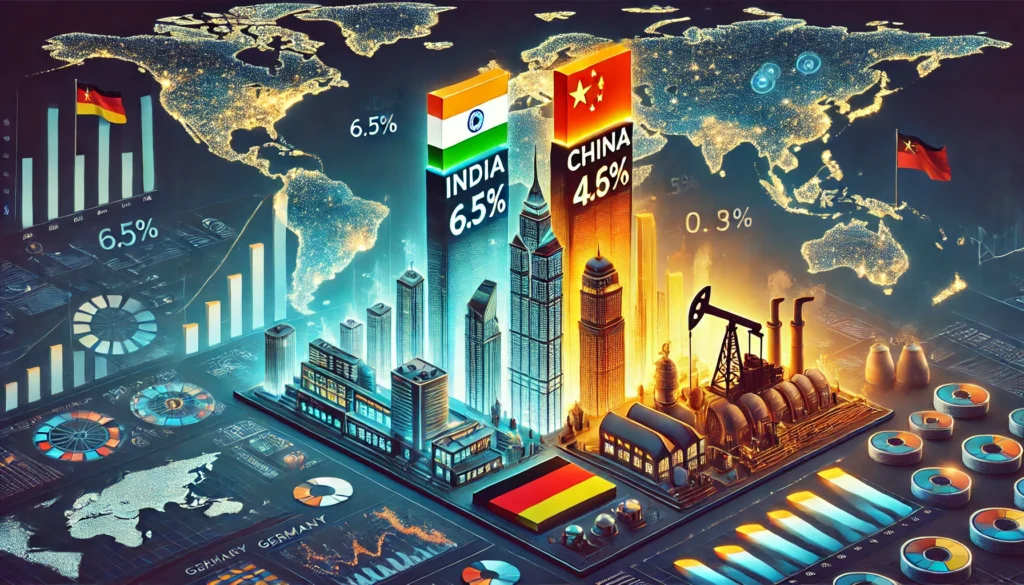The International Monetary Fund (IMF) has forecasted a steady global economic growth rate of 3.3% for 2025 and 2026 in its latest World Economic Outlook report. While India and China are poised to lead this expansion, disparities among major economies reveal a complex global economic landscape.
India and China: Key Growth Drivers
India and China are set to play a pivotal role in driving global growth over the next two years. India’s economy is projected to maintain a strong growth rate of 6.5%, while China is expected to grow at a moderate 4.6%. These figures underscore the dominant role of Asia’s largest economies in the global market.
India’s robust growth stems from strong domestic demand and policy measures aimed at economic stability. Meanwhile, China’s recovery from pandemic-related disruptions is expected to support its steady growth trajectory.

United States: Growth with Caution
In the United States, the IMF predicts economic growth of 2.7% in 2025, a 0.5% increase from earlier estimates. This optimism is fueled by expectations of business-friendly policies under President-elect Donald Trump, including tax cuts and deregulation aimed at boosting corporate productivity.
However, IMF Chief Economist Pierre-Olivier Gourinchas has cautioned against excessive deregulation, warning that it could increase financial risks and create a “boom-bust” cycle in the economy. Additionally, potential trade conflicts under the new administration could hurt global trade, especially export-heavy economies like Germany.
Germany Faces Economic Challenges
Germany, Europe’s largest economy, continues to struggle with economic headwinds. After two consecutive years of recession, Germany’s economy is forecast to grow by a modest 0.3% in 2025, a downward revision of 0.5%. High energy costs and potential U.S. tariffs are among the key factors hampering its recovery.
Other European economies, including Spain, France, and Italy, are expected to perform better, with overall Eurozone growth projected at 1.0% in 2025 and 1.4% in 2026. However, the region faces persistent challenges, including weak manufacturing activity, low consumer confidence, and elevated energy prices.
Energy Costs Impacting the Eurozone
Soaring energy prices remain a significant obstacle for European economies. Gas prices in the Eurozone are still five times higher than those in the United States, undermining industrial competitiveness. The ongoing energy crisis, exacerbated by Russia’s war in Ukraine, continues to weigh heavily on consumer confidence and economic momentum.
Russia’s Short-Lived Growth
Russia’s economy is expected to grow by 3.8% in 2024, largely driven by increased government spending on arms production to sustain its military efforts in Ukraine. However, the IMF predicts a sharp decline in growth to 1.4% in 2025 and 1.2% in 2026, as international sanctions take a heavier toll on the Russian economy.
Global Growth: A Fragile Recovery
The projected global growth of 3.3% marks a slight improvement from the 3.2% expected in 2024 but remains below the pre-pandemic average of 3.7% recorded between 2000 and 2019. Lingering effects of major global disruptions, including the COVID-19 pandemic and geopolitical tensions, continue to hinder a full recovery.
Looking Ahead
The global economic outlook remains uncertain, shaped by divergent growth patterns across regions. While India and China remain bright spots, the United States faces risks from potential trade conflicts and financial instability. Meanwhile, Germany and the Eurozone must address structural challenges to ensure sustainable growth.
As nations navigate these challenges, coordinated efforts and sound policy-making will be essential to achieving balanced and inclusive economic growth worldwide.



